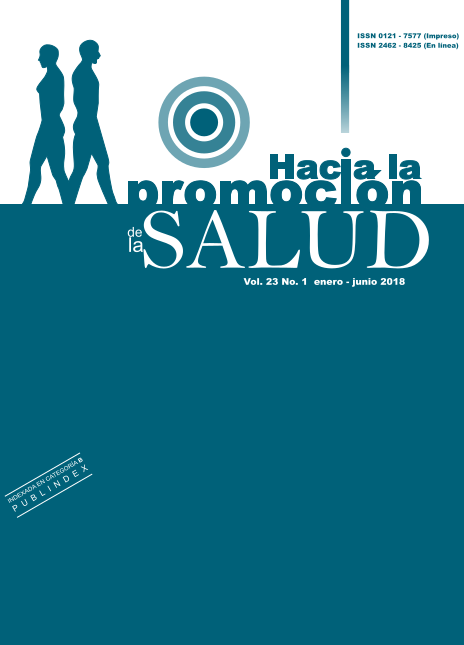Authors
Abstract
Objective: To present the process conducted and its application in order to identify and categorize the seated posture behavior of students in the classroom, using video capture and the development of a graphic matrix to register postures. Material and method: Students from second to eleven grade (between 7 and 16 years of age) male and female from a coeducational school in Bogotá, Colombia participated in the study. The seated postures of 20 students, distributed according to age, school grade, and school dynamics (individual / group), were recorded in ten videos. The postures observed were drawn, categorized and captured in a graphical matrix used as an instrument to identify them, and then, a database was consolidated. Results: A total of 138 posture variations were identified and classified into seven categories. The matrix was applied to compare the frequency of the postures adopted during the first and second half of the class in individual dynamics, the frequency of neck rotation between the two school dynamics, and the frequency of posture categories between class dynamics. Conclusions: The graphic matrix is a qualitative type screening tool which, with the elaboration of a database, makes it possible to calculate the frequencies of movement in the body parts (neck, extremities, and trunk) and percentages of time of permanence in the established categories or in certain posture variation, without the need for specialized equipment or software, or specialized technical staff for data collection and analysis.
References
2. Kamper SJ, Henschke N, Hestbaek L, Dunn KM, Williams CM. Musculoskeletal pain in children and adolescents. Brazilian J Phys Ther. 2016; 20 (3): 275-284.
3. Quintana E, Martín A, Sánchez C, Rubio I, López N, Calvo J. Estudio de la postura sedente en una población infantil. Fisioterapia. 2004; 26 (3): 153-163.
4. Canté-Cuevas X, Kent-Sulú M, Vásquez-Gutiérrez M, Lara-Severino R. Factores posturales de riesgo para la salud en escolares de ciudad del Carmen, Campeche. Unacar Tecnociencia. 2010; 1 (4): 1-15.
5. Troussier B. Comparative study of two different kinds of school furniture among children. Ergonomics. 1999; 42 (3): 516-526.
6. Grimes P, Legg S. Musculoskeletal Disorders (MSD) in School Students as a Risk Factor for Adult MSD: A Review of the Multiple Factors Affecting Posture, Comfort and Health in Classroom Environments. J Human-Environment Syst. 2004; 7 (1): 1-9.
7. República de Colombia. Decreto 1850 por el cual se reglamenta la organización de la jornada escolar y la jornada laboral de directivos docentes y docentes de los establecimientos educativos estatales de educación formal. Bogotá: Ministerio de Educación Nacional; 2002.
8. Panagiotopoulou G, Christoulas K, Papanckolaou A, Mandroukas K. Classroom furniture dimensions and anthropometric measures in primary school. Appl Ergon. 2004; 35 (2): 121-128.
9. Noll M, Candotti CT, Nichele B, Cristina M, Schoenell W, Tiggemann CL, et al. Back pain and the postural and behavioral habits of students in the municipal school network of Teutônia, Rio Grande do Sul. J Hum Growth Dev. 2013; 23 (2): 129-135.
10. Domljan D, Vlaovic Z, Grbac I. Pupils’ working postures in primary school classrooms. Period Biol. 2010; 112 (1): 39-45.
11. Finnish Institute of Occupational Health. PEO (portable ergonomic observation method). Disponible en: http://partner.ttl.fi/en/ergonomics/methods/workload_exposure_methods/table_and_methods/Documents/PEO.pdf.
12. Murphy S, Buckle P, Stubbs D. The use of the portable ergonomic observation method (PEO) to monitor the sitting posture of schoolchildren in the classroom. Appl Ergon. 2002; 33 (4): 365-370.
13. Saarni L, Nygård C, Kaukiainen A, Rimpelä A. Are the desks and chairs at school appropriate? Ergonomics. 2007; 50 (10): 1561-1570.
14. República de Colombia. Resolución 8430 de 1993. Bogotá: Ministerio de Salud; 1993.
15. Losa M, Salvadores P, Sáez A. Actitudes posturales de la extremidad inferior en los escolares durante las clases: estudio observacional. Rev Int Ciencias Podol. 2009; 3 (1): 7-14.
16. República de Colombia. Informe nacional sobre el desarrollo de la educación en Colombia. Bogotá: Ministerio de Educación Nacional ; 2001.
17. Geldhof E, De Clercq D, De Bourdeaudhuij I, Cardon G. Classroom postures of 8-12 year old children. Ergonomics. 2007; 50 (10): 1571-1581.
18. Casas-Sánchez AS, Patiño-Segura MS. Prevalencia y factores asociados con el dolor de espalda y cuello en estudiantes universitarios. Rev la Univ Ind Santander Salud. 2012; 44 (2): 45-55.
19. Trigueiro MJ, Massada L, Garganta R. Back pain in Portuguese schoolchildren: Prevalence and risk factors. Eur J Public Health. 2013; 23 (3): 499-503.
20. Kavalco T. A manifestação de alterações posturais em crianças de primeira a quarta séries do ensino fundamental e sua relação coma ergonomia escolar. Rev Bras Fisioter. 2000; 2 (4).
21. Martínez R del P, Angarita A. Deficiencias posturales en escolares de 8 a 12 años de una institución educativa pública, año 2010. Rev Univ y Salud. 2013; 15 (1): 22-33.
22. Noda W, Tanaka-Matsumi J. Effect of a classroom-based behavioral intervention package on the improvement of children’s sitting posture in Japan. Behav Modif. 2009; 33 (2): 263-273.
23. Hoque ASM, Parvez MS, Halder PK, Szecsi T. Ergonomic design of classroom furniture for university students of Bangladesh. J Ind Prod Eng. 2014; 31 (5): 239-252.
24. Blanco D, Sánchez C, Espinel F. Mobiliario escolar: el reto de la pedagogía al diseño. Iconofacto. 2015; 11 (16): 141-152.
25. ISO. ISO 11226. Ergonomics. Evaluation of static working postures. Ginebra: International Organization for Standardization; 2000.
26. Ariëns G, Bongers P, Douwes M, Miedema M, Hoogendoorn W, van der Wal G et al. Are neck flexion, neck rotation, and sitting at work risk factors for neck pain? Results of a prospective cohort study. Occup Environ Med. 2001; 58 (3): 200-207.


 PDF (Español)
PDF (Español)
 FLIP
FLIP


























